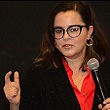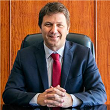COURSE VIDEOS
While it is desirable that you complete the course in the order it is presented, on this page you can find two lists: the first one shows the course videos sorted by expert and the second list is sorted by module. If you would like to quickly watch a video again, you can find it here.
Videos sorted by expert

ADOLFO RUBINSTEIN
Director of the Center for Health Policy Implementation and Innovation (CIIPS) at the IECS. Former Health Minister of Argentina
3.1.4 Adolfo Rubinstein: HBPs in the Context of Universal Health Coverage (UHC).
-

ALEJANDRO GAVIRIA
Former rector at Universidad de los Andes. Former Colombian Minister of Health and Social Protection
-

ALIA LUZ
Project Associate at the International Health Intervention and Technology Assessment Program (HITAP) in Thailand
-

AMANDA GLASSMAN
Executive Vice President of the Center for Global Development (CGD) and Executive Director of CGD Europe
1.1.5 Amanda Glassman: What happens when there is a gap?
2.1.3 Amanda Glassman: Explicit priority setting: more health with the same resources.
3.2.1 Amanda Glassman and Ursula Giedion: 10 Essential Steps in Defining a Benefits Package.
3.2.2 Amanda Glassman and Ursula Giedion: Building the Benefits Package from a Systemic Approach.
7.1.2 Amanda Glassman: Explicit priority setting in the context of a pandemic.
-

ANDRÉS PICHON-RIVIERE
Executive Director of the Institute for Clinical Effectiveness and Health Policy (IECS) and Director of the Department of Health Technology Assessment and Health Economics of Argentina
4.3.3 Andrés Pichon-Riviere: Exploring Further the Cost-Effectiveness Threshold Method.
4.3.4 Andrés Pichon-Riviere: How is the Cost-Effectiveness Threshold Calculated?
4.3.5 Andrés Pichon-Riviere: Beyond the Cost-Effectiveness Threshold.
-

ANNETTE OZALTIN
Senior Fellow at Results for Development (R4D)
4.4.2 Annette Ozaltin and Cheryl Cashin: Costing as a Key Element of Explicit Priority Setting.
-

ANTHONY (TONY) CULYER
Emeritus professor at the University of York, Visiting professor at Imperial College London and Senior researcher at the University of Toronto
5.1.4 Stakeholder participation as a principle of good governance.
-

AURELIO MEJÍA
Regulatory director at the Colombian Ministry of Commerce, Industry, and Tourism. Former technical director of the Institute for Health Technology Assessment (IETS) in Colombia
4.2.9 What Do We Need to Implement Analytical Methods? (Part 1).
-

CAROLINA GÓMEZ
Expert lawyer in pharmaceutical policy
-

CHERYL CASHIN
Director in global health practice at Results for Development (R4D)
4.4.2 Annette Ozaltin and Cheryl Cashin: Costing as a Key Element of Explicit Priority Setting.
-

DAVID WATKINS
Assistant professor in the Division of General Internal Medicine and in the Department of Global Health at the University of Washington in Seattle
-

DIANA PINTO
Doctor of Science in Population and International Health
1.1.6 Diana Pinto: How do we improve spending efficiency in the context of UHC?
2.1.1 Diana Pinto: What are implicit and explicit priority setting?
-

EDUARDO GONZÁLEZ-PIER
Global Associate at The Wilson Center. Former Undersecretary of integration and development of the health sector in the Mexican Ministry of Health
3.2.6 Eduardo González Pier: Key Elements for a Successful HBP Implementation.
-

FATIMA SULEMAN
Professor of pharmaceutical sciences at the School of Health Sciences at the University of KwaZulu-Natal in South Africa
6.4.10 Fatima Suleman: Generic medicines and strategies to promote their use.
-

FERDINANDO REGALIA
Chief of the Social Protection and Health Division at the IDB
1.1.1 Ferdinando Regalía: UHC and the financial restrictions on achieving it.
7.2.1 Ferdinando Regalia: Decisions and processes to achieve more health with the same resources.
-

FRANCIS RUIZ
Senior policy analyst for the International Decision Support Initiative (iDSI) and senior adviser to the Institute of Global Health Innovation at the Imperial College London
4.2.1 Francis Ruiz: HTA as a Method for Selecting What to Finance (Part 1).
-

JAIME ESPÍN
Professor at the Andalusian School of Public Health
6.2.4 Jaime Espín: Conditions that enable competition in the medicine market.
-

JAVIER GUZMÁN
Director of the Global Health Policy Program at the Center for Global Development (CGD)
7.1.4 Javier Guzmán: Affordable medicines in the context of a pandemic.
-

JOAN ROVIRA FORNS
Associate Professor at the Andalusian School of Public Health and Emeritus Professor of the Department of Economic Theory at the University of Barcelona
6.2.3 Joan Rovira: What are efficient prices and why are they relevant to progress towards UHC?
6.4.8 Joan Rovira: Taking an in-depth look at value-based pricing.
-

JONG-SU RYU
Professor at Yonsei University Postgraduate School of Public Health
6.5.2 Jong-su Ryu: Optimizing medicine prices on the pathway to UHC: the case of Korea.
-

KALIPSO CHALKIDOU
Director of the Health Financing Department at the Global Fund to Fight HIV / AIDS, Tuberculosis and Malaria
4.2.2 Kalipso Chalkidou: HTA as a Method for Selecting What to Finance (Part 2).
-

KARL LAUTERBACH
Member of the German parliament ("Bundestag"). Professor at Harvard University and the University of Cologne.
2.2.4 Karl Lauterbach: Explicit priority setting without HBP: The German case.
-

KATHARINA HAUCK
Adjunct professor of Health Economics in the Department of Infectious Disease Epidemiology, Imperial College London
4.2.10 Katharina Hauck: What Do We Need to Implement Analytical Methods? (Part 2).
-

LEANDRO SAFATLE
Expert in drug price regulation. Former executive secretary of CMED/ANVISA in Brazil
6.3.1 Leandro Safatle: Relevant markets and market structure.
6.3.2 Leandro Safatle: Market failures that affect the price of medicines.
6.3.3 Leandro Safatle: Cross-cutting factors that affect the price of medicines.
6.5.1 Leandro Safatle: Brazil's experience with medicine price regulation.
-

LEONARDO ARREGOCÉS
Director of Medicines and Health Technologies at the Colombian Ministry of Health and Social Protection
6.2.1 Leonardo Arregocés: Types of medicines and their markets.
-

LORENA PRIETO
Professor at the Postgraduate School at the University of the Pacific [Universidad del Pacífico*] and the Postgraduate School at the Peruvian University of Applied Sciences [Universidad Peruana de Ciencias Aplicadas*]
6.4.3 Lorena Prieto: Peru's experience with electronic reverse auctioning.
-

MANUEL ESPINOZA
Consultant at UNOPS and associate professor and head of the Health Technology Assessment Unit at the Center for Clinical Research at Pontifical Catholic University of Chile [Pontificia Universidad Católica de Chile*]
-

MARCELLA DISTRUTTI
Health Specialist in the Social Protection and Health Division and coordinator of the IDB CRITERIA Network
2.2.1 Marcella Distrutti: Main explicit priority setting tools.
3.1.1 Marcella Distrutti: What Is - and What Is Not - a Health Benefits Package?
6.5.4 Marcella Distrutti: 5 lessons to achieve affordable medicine prices.
-

MARÍA LUISA ESCOBAR
Independent international consultant, specialist in health policy innovation
-

MARIANA BARRAZA
Deputy leader of the Better Health Program team under the Prosperity Fund and senior consultant in pharmaceutical policy and health systems
6.4.4 Mariana Barraza: Centralized medicine price negotiation. The experience of Mexico.
-

MARTÍN SABIGNOSO
Health policy expert
3.1.5 Martin Sabignoso: Health Benefits Packages: A Heterogeneous Universe.
-

OLÈ NORHEIM
Professor of Medical Ethics at the University of Bergen and Adjunct Professor at Harvard University School of Public Health
2.1.2 Olè F. Norheim: The benefits from explicit priority setting.
4.1.2 Olè Norheim: Criteria for Evaluating the Services that Will be Covered with Public Resources.
5.2.1 Olè Norheim: An ethical view of explicit priority setting.
-

PAUL RODRÍGUEZ
Professor in the School of Economics at the National University of Rosario
6.1.2 Paul Rodríguez: Key economic concepts to support the search for more affordable prices.
-

PETER SMITH
Emeritus professor at Imperial College London and Professor at the York University Center for Health Economics
4.1.1 Peter Smith: Why Should Analytical Methods Be Used to Set Priorities?
4.2.3 Peter Smith: 3 Methods for Evaluating Technologies and Prioritizing.
4.2.5 Peter Smith: CEA for Coverage Decisions.
4.3.1 Peter Smith: How to Decide Which Evaluated Technology Is Financed.
-

RICARDO BITRÁN
Specialist consultant in economics and health system financing. Founding partner and president of Bitrán & Associates
4.4.3 Ricardo Bitran: Why and How to Calculate the Cost of an HBP.
4.4.5 Ricardo Bitran: Technical Challenges in the Costing of an HBP.
4.4.6 Ricardo Bitrán: The Importance of a Second Costing and its Data Sources.
4.4.7 Ricardo Bitran: Challenges and Recommendations for Costing an HBP.
-

ROBERT KLITZMAN
Director of the master's program in Bioethics and a member of the Division of Psychiatry, Law and Ethics at Columbia University
7.1.3 Robert Klitzman: Ethical considerations during the COVID-19 pandemic.
-

SABINE VOGLER
Head of the Pharmacoeconomics Department of the Austrian Public Health Institute and Head of the WHO Collaborating Center for Pharmaceutical Pricing and Reimbursement Policies
6.4.1 Sabine Vogler: Overview of policies for achieving fair prices.
-

TOMMY WILKINSON
Senior Researcher at the University of Cape Town
6.5.3 Tommy Wilkinson: Explicit priority setting in New Zealand.
-

URSULA GIEDION
Coordinator of IDB's CRITERIA Network and independent specialist consultant in health economics and health care financing
1.1.3 Ursula Giedion: Why does health spending keep increasing?
3.2.1 Amanda Glassman and Ursula Giedion: 10 Essential Steps in Defining a Benefits Package.
3.2.2 Amanda Glassman and Ursula Giedion: Building the Benefits Package from a Systemic Approach.
5.1.1 Ursula Giedion: Why is good governance so important in explicit priority setting?
6.2.2 Ursula Giedion: What is the relationship between medicine prices, health expenditure and UHC?
-

VERONIKA WIRTZ
Associate Professor, Boston University School of Public Health
6.4.2 Veronica Wirtz: Tools to achieve more affordable prices for off-patent medicines.
-

WOLFGANG GREINER
Professor in the School of Public Health at Bielefeld University
6.4.6 Wolfgang Greiner: Tools for achieving more affordable prices for patented medicines.
Videos in order of appearance
-
Module 1
The gap between available resources and the population's needs
1.1.1 UHC and the financial restrictions on achieving it - Ferdinando Regalia
1.1.3 Why does health spending keep increasing? - Ursula Giedion
1.1.5 What happens when there is a gap? - Amanda Glassman
1.1.6 How do we improve spending efficiency in the context of UHC? - Diana Pinto
-
Module 2
Explicit priority setting: An inescapable need
2.1.1 What are implicit and explicit priority setting? - Diana Pinto
2.1.2 The benefits from explicit priority setting - Olè Norheim
2.1.3 Explicit priority setting: more health with the same resources - Amanda Glassman
2.2.1 Main explicit priority setting tools - Marcella Distrutti
2.2.2 What is the best explicit priority setting tool that a country can adopt? - Eduardo González-Pier y Kalipso Chalkidou
2.2.3 Explicit priority setting in Chile - Manuel Espinoza
2.2.4 Explicit priority setting without HBP: The German case - Karl Lauterbach
-
Módulo 3
What is a Health Benefits Package (HBP) and how is it developed?
3.1.1 What Is - and What Is Not - a Health Benefits Package? - Marcella Distrutti
3.1.4 HBPs in the Context of Universal Health Coverage (UHC) - Adolfo Rubinstain
3.1.5 Health Benefits Packages: A Heterogeneous Universe - Martín Sabignoso
3.2.1 10 Essential Steps in Defining a Benefits Package - Amanda Glassman y Ursula Giedion
3.2.2 Building the Benefits Package from a Systemic Approach - Amanda Glassman y Ursula Giedion
3.2.6 Key Elements for a Successful HBP Implementation - Eduardo González Pier
-
Módulo 4
Analytical Methods for Defining and Managing Explicit Priority-Setting Mechanisms
4.1.1 Why Should Analytical Methods Be Used to Set Priorities? - Peter Smith
4.1.2 Criteria for Evaluating the Services that Will be Covered with Public Resources - Olè Norheim
4.2.1 HTA as a Method for Selecting What to Finance (Part 1) - Francis Ruiz
4.2.2 HTA as a Method for Selecting What to Finance (Part 2) - Kalipso Chalkidou
4.2.3 3 Methods for Evaluating Technologies and Prioritizing - Peter Smith
4.2.5 CEA for Coverage Decisions - Peter Smith
4.2.8 An HBP Model Based on DCP3 Evidence - David Watkins
4.2.9 What Do We Need to Implement Analytical Methods? (Part 1) - Aurelio Mejía
4.2.10 What Do We Need to Implement Analytical Methods? (Part 2) - Katharina Hauck
4.3.1 How to Decide Which Evaluated Technology Is Financed - Peter Smith
4.3.3 Exploring Further the Cost-Effectiveness Threshold Method - Andrés Pichon-Riviere
4.3.4 How is the Cost-Effectiveness Threshold Calculated? - Andrés Pichon-Riviere
4.3.5 Beyond the Cost-Effectiveness Threshold - Andrés Pichon-Riviere
4.3.6 Challenges and Constraints in Choosing Well: The Experience of Latin America - Andrés Pichon-Riviere
4.4.2 Costing as a Key Element of Explicit Priority Setting - Annette Ozaltin y Cheryl Cashin
4.4.3 Why and How to Calculate the Cost of an HBP - Ricardo Bitrán
4.4.5 Technical Challenges in the Costing of an HBP - Ricardo Bitrán
4.4.6 (OPTIONAL) The Importance of a Second Costing and its Data Sources - Ricardo Bitrán
-
Módulo 5
Critical factors in the design and implementation of explicit priority-setting policies
5.1.1 Why is good governance so important in explicit priority setting? - Ursula Giedion
5.1.2 Principles of good governance: transparency, participation, coherence and consistency - Javier Guzmán
5.1.4 Stakeholder participation as a principle of good governance - Anthony (Tony) Culyer
5.2.1 An ethical view of explicit priority setting - Olè Norheim:
5.2.2 Ethical dilemmas arising in explicit priority setting policy from the experience of a decision maker - Alejandro Gaviria
5.2.4 The right to health and explicit priority setting: incompatible approaches? - María Luisa Escobar
-
Módulo 6
Searching for more affordable medicine prices
6.1.2 Key economic concepts to support the search for more affordable prices - Paul Rodríguez
6.2.1 Types of medicines and their markets - Leonardo Arregocés
6.2.2 What is the relationship between medicine prices, health expenditure and UHC? - Ursula Giedion
6.2.3 What are efficient prices and why are they relevant to progress towards UHC? - Joan Rovira
6.2.4 Conditions that enable competition in the medicine market - Jaime Espín
6.3.1 Relevant markets and market structure - Leandro Safatle
6.3.2 Market failures that affect the price of medicines - Leandro Safatle
6.3.3 Cross-cutting factors that affect the price of medicines - Leandro Safatle
6.4.1 Overview of policies for achieving fair prices - Sabine Vogler
6.4.2 Tools to achieve more affordable prices for off-patent medicines - Veronika Wirtz
6.4.3 (OPTIONAL) Peru's experience with electronic reverse auctioning - Lorena Prieto
6.4.4 (OPTIONAL) Centralized medicine price negotiation. The experience of Mexico - Mariana Barraza
6.4.5 Clinical benefit evaluation and cost-effectiveness analysis to establish prices for patented medicines - Wolfgang Greiner
6.4.6 Tools for achieving more affordable prices for patented medicines - Wolfgang Greiner
6.4.8 (OPTIONAL) Taking an in-depth look at value-based pricing - Joan Rovira
6.4.9 (OPTIONAL) A closer look at international reference pricing - Carolina Gómez
6.4.10 Generic medicines and strategies to promote their use - Fatima Suleman
6.5.1 Brazil's experience with medicine price regulation - Leandro Safatle
6.5.2 Jong-su Ryu: Optimizing medicine prices on the pathway to UHC: the case of Korea - Jong-Su Ryu
6.5.3 Explicit priority setting in New Zealand - Tommy Wilkinson
6.5.4 5 lessons to achieve affordable medicine prices - Marcella Distrutti
-
Módulo 7
Applying lessons learned in real life
7.1.2 Explicit priority setting in the context of a pandemic - Amanda Glassman
7.1.3 Ethical considerations during the COVID-19 pandemic - Robert Klitzman
7.1.4 Affordable medicines in the context of a pandemic - Javier Guzmán
7.2.1 Decisions and processes to achieve more health with the same resources - Ferdinando Regalia